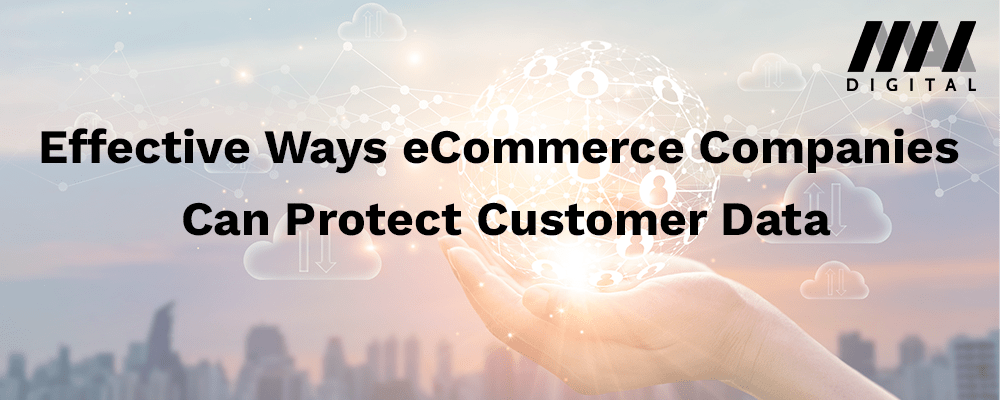Effective Ways eCommerce Companies Can Protect Customer Data

Last week (02/21/22), OpenSea, the eBay of NFTs, lost users’ assets worth $200 million to a phishing scam. OpenSea users, NFT skeptics, and everyone in-between have been talking about this situation since then. OpenSea is getting the flack for not being secure enough to protect its customer data from hackers — the hackers got the emails of several OpenSea users somehow, right? While OpenSea is not the typical subject of eCommerce conversations, similar events often happen in the traditional eCommerce industry, and it always raises concerns among customers.
Present-day buyers are very informed about eCommerce, and they have high expectations. It’s no surprise many avoid eCommerce companies with a history of data breaches. It doesn’t matter to them that the company has the products they need at the best prices, customers want to know whether their personal data is secure. Hence, as you are investing in marketing and putting aside money to provide better products/services and experiences, you also need to invest in security.
Here are 12 effective cybersecurity protocols you need to include in your eCommerce strategy to protect your customer data.
Use Best Cybersecurity Practices for Data Storage
To ensure the secure protection of customer data, you have to adopt cybersecurity best measures to storing data, which means replication, data isolation, zero trust, backup, and DRP. You should also set up the best cybersecurity measures to secure applications that access data which include; multifactor authentication, bot management, implementation of bug bounty, protection against OWASP Top 10, and vulnerability scanning.
Protection of personally identifiable information (PII) is a big part of cybersecurity. Always encrypt PII and put the systems that store PII behind a firewall. Use data-at-rest and in-transit encryption solutions. Additionally, PII data fall within the scope of privacy laws such as GDPR and CCPA, so make sure your data storage procedures comply with necessary privacy laws. You can use anonymity or pseudonymity to make your PII fields and data more secure.
Always store sensitive data separately from personal data. If a hacker gets hold of a valid credit card number, they still need to tie the number to an actual user to get the attached name, expiration date, and other details about the card. If you store sensitive data separately from personal data, then all the hacker has is a meaningless set of numbers.
Use Encryption-In-Use Solutions
Present-day cybersecurity measures support encryption-in-use for large database apps. Use it simultaneously with data-at-rest encryption solutions. The combined use of both types of encryption solutions will help reduce internal and external threats that are rampant these days.
Pay Attention to Asset and Configuration Management
Besides encryption and data storage, you should also focus on asset and configuration management. Many data breaches have happened because the company forgot that they stored data on particular cloud storage and didn’t put in any security measures. You can’t secure what you don’t know you have. Hackers will always have a field day because of this error, so make sure you understand every detail of your infrastructure to prevent such breaches.
Keep an Inventory of Service Components and Test Regularly
As a business, if you have an internet-facing app, make sure to keep an inventory of every service component with their dependencies, and conduct passive and active scanning. Also, always ask 3rd parties to perform penetration tests, and carry out red team/blue team exercises.
Additionally, use automated testing solutions. Since you collect and store customer data, ensure that you use automated proactive security measures for discovering threats. Your security teams should continuously test your security controls to monitor their effectiveness in protecting customer data.
Move to Mesh Architecture
If you haven’t already, you need to transition to a mesh architecture because it provides more effective security for all assets, regardless of their locations. A mesh architecture uses a composable security approach based on identity, thereby creating scalable and interoperable IT services, which make it easier to provide security all across the services.
Teach Employees Security Risks
As your DevOps and software team(s) build and release eCommerce features to meet your customers’ demands, teach them about security vulnerabilities so that they can implement the mindset as they build. Your DevOps and software team should know about vulnerabilities like the OWASP Top 10 and possible loopholes in their codes that hackers can exploit. Knowing about numerous vulnerabilities will encourage them to include level mitigation controls in their code before deployment.
Now that remote working is more common, keep educating your remote staff about security risks. Beyond that, put in place thorough security protocols on the devices and accounts of your on-site and remote/hybrid employees.
Use Automated Digital Certificate Management
Your cybersecurity measures should eliminate human error and downtime, which is why you need to use automated digital certificate management. Insist on future-proofing the security of all your encrypted data and confirm that they provide a trail to quantum resistance.
Implement 2-Factor Authentication
If you are not already using 2-factor authentication, you are lagging behind. 2-factor authentication provides an extra security layer that reduces unauthorized access and fraud. 2-factor authentication will give your customers more assurance that their accounts and data are well secure.
Eliminate Passwords
In your attempt to eliminate human error as part of your cybersecurity measures, eliminate passwords. Your customers and employees don’t have to enter their passwords every time. Instead, automate the identity infrastructure, so that your systems can automatically identify who/what accessed, what they accessed, when, and how they accessed.
Use Behavioral Analytics to Detect Suspicious Behavior
Being proactive helps you use more effective measures such as a behavioral analytics system to detect suspicious behaviors. Set up a behavioral analytics system that compares normal behavior and functionality from the client-side with user profiles in order to detect suspicious behaviors and quantify their risks. Doing this will let you detect possible risks fast, investigate, and prevent or mitigate attacks before causing damage.
Adopt the Least-Privileged Principle
Learn to grant access based on relevancy because it’s not all your employees that should have access to all your data. Instead of granting everyone the same access to all data, determine who needs read-only and who needs write permission, and grant access based on their responsibility. Choose data protection over speed.
Meet Required Privacy Standards for Mobile Apps
If you have a mobile app, ensure that it meets the required security and privacy standards. Marketplaces such as Apple and Google also have privacy standards, so ensure that your mobile app meets their standards to avoid publishing delays.

 1-888-553-8776
1-888-553-8776
